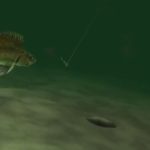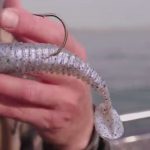Multiple Personality Pike Contrasting Presentations for Contrasting Behavior
 Watching a thick pike approach a minnow through a three-foot by three-foot darkhouse hole can make your knees shake. An aggressive fish will dart in and strike a bait at full speed, engulfing the frantically writhing target before the angler has a chance to react. Other times aggressive pike streak into view and suddenly stop, allowing a heart attack bound shiner or sucker minnow the chance to tail-tickle the predators lips before becoming lunch. Both scenarios result in, at minimum, a chance for the angler to ice the water wolf.
Watching a thick pike approach a minnow through a three-foot by three-foot darkhouse hole can make your knees shake. An aggressive fish will dart in and strike a bait at full speed, engulfing the frantically writhing target before the angler has a chance to react. Other times aggressive pike streak into view and suddenly stop, allowing a heart attack bound shiner or sucker minnow the chance to tail-tickle the predators lips before becoming lunch. Both scenarios result in, at minimum, a chance for the angler to ice the water wolf.
However, the probability is equal of having a fish with a snobbish demeanor slink slowly to the outskirts of view, watching the silver platter caliber bait with as much enthusiasm as a couch potato succumbing to reruns. You jig. It sits. You jerk. It sits. You try every technique in your repertoire. It sits.
An aggressive pike is easy to please, satisfied by many different offerings, but a fish negative in attitude will only settle upon very specific requirements. They’re freshwater snobs. Aggressive fish favor lively, highly assertive jigging and swimming, but lethargic fish typically do not. So where does an angler find a middle ground between what is acceptable by both aggressive and non-aggressive pike? In reality a compromise may not be the answer. Instead, focus on aggressive and passive fish as two separate entities.
In states where multiple lines may be used for ice-fishing, initially employ two diversely different techniques; one dynamically assertive to entertain the mean, tooth gnashing northern with animated fins and fury, the other practically motionless, paying homage to the sloth-like characteristics of a passive pike.
Find the Ferocious
First, drill holes along weed edges, on top of weed flats and directly adjacent to weed clumps. The vegetation serves two purposes: First, it provides excellent cover for smaller fish that want to be spared from a toothy demise, and second, it gives the predator some camouflage, enabling it to attack some of the reluctant-to-be-eaten fish anyway.
Eight to twelve feet is a good focal point for hungry northerns, but keep in mind that those fish will often swim in water as shallow as a couple of feet and that they will prefer areas that have deep water refuge within a hundred yards or so.
 Spoon Feed ‘Em
Spoon Feed ‘Em
A hand held medium heavy rod teamed up with a reel that has the capacity to hold a lengthy quantity of braid or monofilament will rip a moderate sized jigging spoon around the weedy dancefloor, reflecting, vibrating and ultimately mandating attention from any nearby pike. This technique consists of quickly jerking the spoon upward 12-24 inches then allowing it to fall on a slack line. This technique will gain attention from both aggressive and non-aggressive fish, but the lethargic ones will come in to range, then simply watch the action instead of reactively attacking.
Kick Back and Relax
Tip ups can be a productive and fun way to target big pike, especially with a group of people to play "free for all" when a flag pops up. A lively minnow circling the circumference of the hole will draw in curious northerns, but some won’t want to put forth the effort in chasing down a meal. That’s when less is more. A large minnow, 7-10 inches in length is the right size for truly monstrous northerns, but try one that’s dead or close to it. One of my favorite big pike formulas is to cut open the belly of the large minnow and hang it upside down at a depth allowing less than six inches between it’s back and the bottom of the lake. This is the ultimate offering for a lazy winter scavenger because the effort involved in obtaining the meal is minimal. Although anglers don’t typically think of northern pike as apathetic, some of the biggest won’t move a fin unless they’re confident the food can easily be eaten, giving reason to challenge a pike to approach your lifeless bait.





